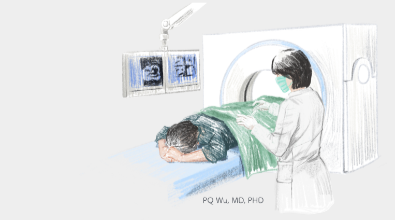After physical and imaging examinations, if the doctor suspects malignant osteosarcoma occurs, the next most important step is conducting a biopsy test. A biopsy test uses a slightly invasive way to take some of the micro-tissue in tumor cells and then subject it to pathologist's diagnosis. A biopsy is essential in osteosarcoma examination, and the general methods of biopsy are roughly two types:
With the assistance of radiologists on using imaging equipment, orthopedic surgeons will place a special needle for biopsy inside the tumor and take the tumor tissue for testing.
The choices of imaging instruments, including sonography or computer tomography, depend on the tumor's size, location, and characteristics.

If the tumor locates near the surface and can be easily touched, most of us will choose to use ultrasonic positioning. Conversely, if the tumor locates deep inside the body, such as the pelvic cavity, we will use computer tomography to position it. The advantages of this approach are:
1. It can be done quickly and efficiently.
2. It won't require an operating room to carry out anesthesia and minor surgery.
At present, we use this approach for biopsy testing in the Therapeutical and Research Center of Musculoskeletal Tumor, Taipei Veterans General Hospital. However, this approach also has its limitations:
1. Younger children may not be able to cooperate on biopsy sampling.
2. It requires radiologists with abundant experience to conduct.
3. Since the needle used for tumor sampling is relatively thin, and the amount of specimens taken out is lesser, sometimes the pathologist cannot determine the result.
Hence, when necessary, we still need to conduct an incision biopsy.
Incision biopsy requires patients to enter the operating room and take anesthesia. The doctor will create as 'small' a wound as possible, in the 'appropriate' position, and with the 'correct' incision, to sample the 'appropriate amount' of the tumor. As you can see, I used many quotation marks in the previous sentence, meaning that there are quite a few details to be taken care of during the surgery.

If the doctor does not use the correct way to carry out the biopsy, sometimes it can lead to relatively serious consequences. Therefore, we recommend that even a relatively 'simple' minor surgery be performed by an orthopedic surgeon specializing in osteosarcoma to avoid complications. Moreover, incision biopsy not only passes the limitation in image-guided biopsy but also brings two advantages:
1. If the tumor has less calcium content, immediate identification of tumor malignancy using a frozen biopsy approach can be carried out. Usually, if malignant cells were found in the frozen biopsy, the tumor must be a malignant tumor. However, it is not 100% benign if the malignant cells were not found in the frozen biopsy. We will have to wait for the official biopsy report in a few days to make a judgment.
2. Because patients with serious malignant osteosarcoma will need chemotherapy, they all need to be placed with artificial blood vessels. Therefore, if the frozen biopsy indicates a malignant tumor, we can place the artificial blood vessel (port-A) in the same operation to reduce the inconvenience and distress of the patient to re-enter the operating room.
For more information about biopsy, including the options and indications, we recommended consulting with the physicians specialized in osteosarcoma to help patients decide!


